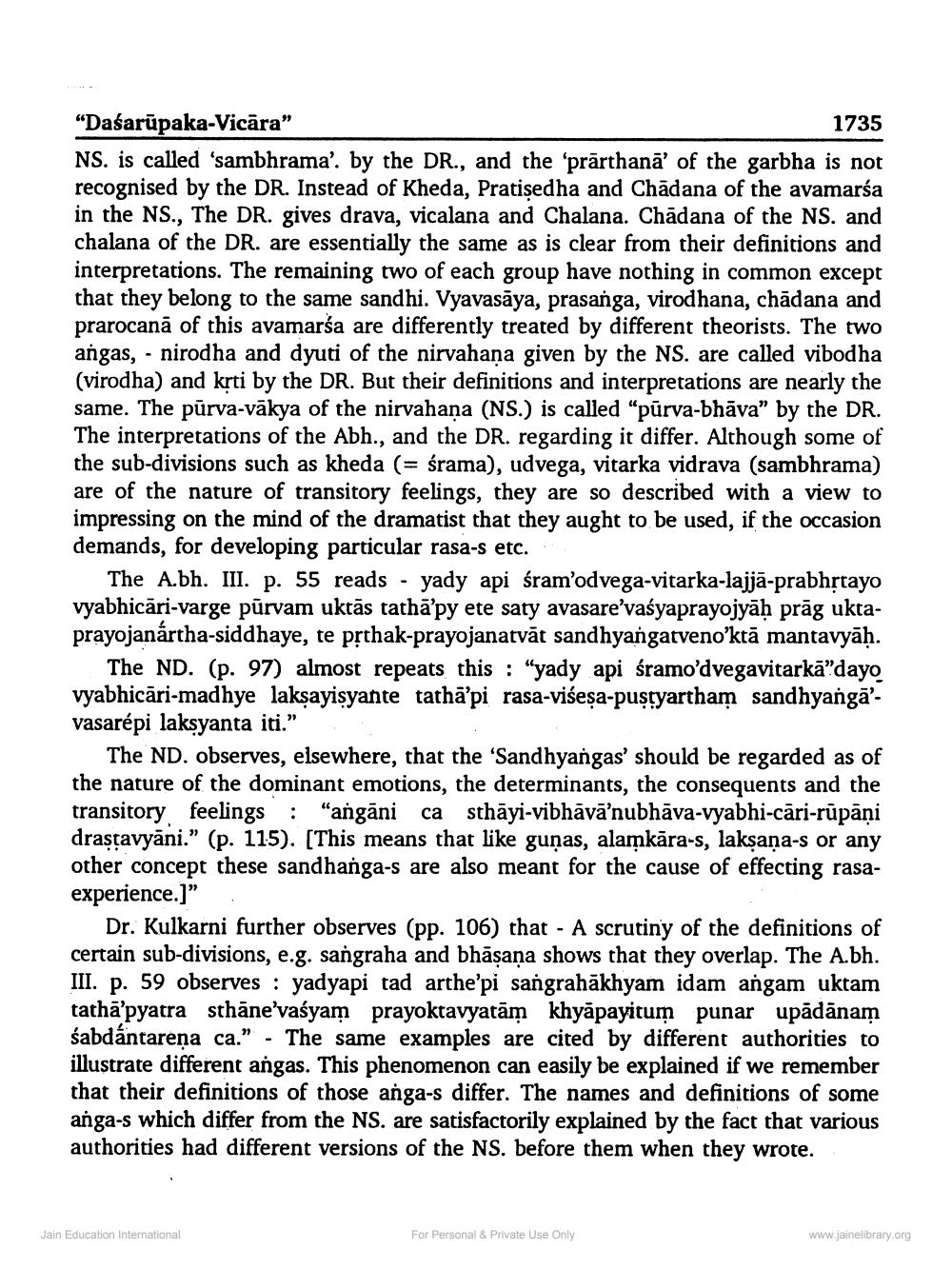________________
"Dasarūpaka-Vicāra"
1735 NS. is called 'sambhrama'. by the DR., and the 'prārthana' of the garbha is not recognised by the DR. Instead of Kheda, Pratisedha and Chādana of the avamaría in the NS., The DR. gives drava, vicalana and Chalana. Chādana of the NS. and chalana of the DR. are essentially the same as is clear from their definitions and interpretations. The remaining two of each group have nothing in common except that they belong to the same sandhi. Vyavasāya, prasanga, virodhana, chādana and prarocanā of this avamarśa are differently treated by different theorists. The two angas, - nirodha and dyuti of the nirvahana given by the NS. are called vibodha (virodha) and krti by the DR. But their definitions and interpretations are nearly the same. The pūrva-vākya of the nirvahana (NS.) is called "pūrva-bhāva” by the DR. The interpretations of the Abh., and the DR. regarding it differ. Although some of the sub-divisions such as kheda (= śrama), udvega, vitarka vidrava (sambhrama) are of the nature of transitory feelings, they are so described with a view to impressing on the mind of the dramatist that they aught to be used, if the occasion demands, for developing particular rasa-s etc.
The A.bh. III. p. 55 reads - yady api śram'odvega-vitarka-lajjā-prabhịtayo vyabhicāri-varge pūrvam uktās tathā'py ete saty avasare’vaśyaprayojyāḥ prāg uktaprayojanártha-siddhaye, te prthak-prayojanatvāt sandhyangatveno’ktā mantavyāḥ.
The ND. (p. 97) almost repeats this : “yady api śramo'dvegavitarkā”dayo vyabhicāri-madhye laksayisyante tathā'pi rasa-višesa-pustyartham sandhyangā'vasarépi laksyanta iti.”
The ND. observes, elsewhere, that the 'Sandhyangas' should be regarded as of the nature of the dominant emotions, the determinants, the consequents and the transitory feelings : "angāni ca sthāyi-vibhāvā’nubhāva-vyabhi-cāri-rūpāņi drastavyāni.” (p. 115). (This means that like gunas, alamkāra-s, laksana-s or any other concept these sandhanga-s are also meant for the cause of effecting rasaexperience.]”
Dr. Kulkarni further observes (pp. 106) that - A scrutiny of the definitions of certain sub-divisions, e.g. sangraha and bhāsana shows that they overlap. The A.bh. III. p. 59 observes : yadyapi tad arthe’pi sangrahākhyam idam angam uktam tathā'pyatra sthāne'vasyam prayoktavyatām khyāpayitum punar upādānam śabdántarena ca." - The same examples are cited by different authorities to illustrate different angas. This phenomenon can easily be explained if we remember that their definitions of those anga-s differ. The names and definitions of some anga-s which differ from the NS. are satisfactorily explained by the fact that various authorities had different versions of the NS. before them when they wrote
Jain Education International
For Personal & Private Use Only
www.jainelibrary.org




